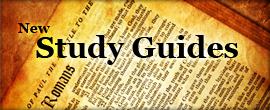What about 1 John 1:9? Part two.
Posted: Wed. Dec, 13 2017
1 John 1:9
9 If we confess our sins, He is faithful and righteous to forgive us our sins and to cleanse us from all unrighteousness.
Getting it right
Last time, we saw that the popular interpretation of this verse raises several problems in light of what the rest of the New Testament epistles say.
The conflicts involve vital subjects for Christians, including the forgiveness of sins, fellowship with God, our sanctification, and even the gospel.
Since the Holy Spirit inspired every word of the Bible in the original texts, it cannot be the case that 1 John and the epistles of Paul simply contradict each other, meaning one is wrong and the other is right.
So the answer must lie elsewhere.
Is there something about 1 John that distinguishes this letter from the epistles of Paul, in such a way as to clear up any seeming contradictions? Are we looking at 1 John 1:9 the wrong way? Does it serve a different purpose from the one that is popularly attributed to it?
We should care very much about getting 1 John 1:9 right because a lot is at stake in interpreting this verse properly.
In fact, the way we interpret this verse can change how we view our redemption, our justification and our sanctification. These are the fundamentals of the gospel of Jesus Christ.
Given that, we are now going to conduct a comprehensive study of 1 John 1:9.
We begin with our top-down look at 1 John 1:9.
This week, we will answer these three questions:
- Who is the author, and what else is said about him in the New Testament?
- Who are the recipients of the epistle of 1 John? What facts about them can we glean from the letter of 1 John?
- What is the relationship between the author and the recipients?
The author of 1 John
The author of 1 John does not identify himself by name in the letter.
Nevertheless, the letter does provide some significant information about him.
Also wrote the gospel of John
First, there is solid evidence that the author of 1 John also wrote the gospel of John. Why?
For one thing, the language and concepts found in 1 John are strikingly similar to those of the gospel of John. Examples include the Word, light, eternal life, passing from death to life, and the commandment to love one another.
Most pronounced of all are the similarities between the Prologue of the Gospel of John (JOH 1:1-18) and the introductory section of 1 John ( 1JO 1:1-7).
In addition, the gospel and 1 John are also linked by the purpose of each book, as each has to do with faith in Christ and receiving eternal life.
JOH 20:31
31 but these have been written so that you may believe that Jesus is the Christ, the Son of God; and that believing you may have life in His name.
1JO 5:13
These things I have written to you who believe in the name of the Son of God, so that you may know that you have eternal life.
The gospel of John is written in the hope that people will believe in Christ, while 1 John is written to give assurance to those who already believe in Christ.
So it will come as no surprise that we will consult the gospel of John for insight into words and concepts we study in 1 John.
Witnessed the incarnate Christ
The second thing we know is that the author was one of a group of personal witnesses of the incarnate Jesus Christ during His first advent.
1JO 1:1-3
What was from the beginning, what we have heard, what we have seen with our eyes, what we have looked at and touched with our hands, concerning the Word of Life — 2 and the life was manifested, and we have seen and testify and proclaim to you the eternal life, which was with the Father and was manifested to us — 3 what we have seen and heard we proclaim to you also, so that you too may have fellowship with us; and indeed our fellowship is with the Father, and with His Son Jesus Christ.
Writes as an individual
And the third thing about the letter’s author is that he writes as an individual. He repeatedly refers to himself in the first person singular “I” (2:1, 7,8,12,13,14,21,26; 5:13).
1JO 2:12-13
12 I am writing to you, little children, because your sins have been forgiven you for His name's sake. 13 I am writing to you, fathers, because you know Him who has been from the beginning. I am writing to you, young men, because you have overcome the evil one.
This is a strong indication that the author was well-known to the recipients of the letter. Indeed, he has a close, fatherly relationship with them.
So while the author and the recipients are not named, 1 John is clearly a letter written by one individual to a specific community, and they were very familiar with one another at that time.
The apostle John
Finally, the evidence largely points to the apostle John as the author of the letter. He is identified in the gospels as the brother of James, son of Zebedee, and the (self-proclaimed) “disciple whom Jesus loved”.
MAT 10:2
Now the names of the twelve apostles are these: The first, Simon, who is called Peter, and Andrew his brother; and James the son of Zebedee, and John his brother;
JOH 19:26
When Jesus then saw His mother, and the disciple whom He loved standing nearby, He said to His mother, " Woman, behold, your son!"
Biographical information
John was the only one of the twelve apostles who was present at the cross when Jesus died there. He was also the first apostle to see the empty tomb three days later. So when he writes about the blood of Christ and eternal life, he does so with the utmost credibility.
John was also in the Lord’s “inner circle” among the apostles, joined by Peter and James. There were certain events in the life of Jesus that only the inner circle was allowed to witness.
MAT 17:1-2
1 Six days later Jesus took with Him Peter and James and John his brother, and led them up on a high mountain by themselves. 2 And He was transfigured before them; and His face shone like the sun, and His garments became as white as light.
The apostle John also wrote 2 and 3 John, as well as the book of Revelation.
We find more biographical information about John in the book of Acts and the letter to the Galatians.
Acts presents the history of the early church from its inception in Jerusalem at Pentecost to the ministry of Paul to the Gentiles. From Acts chapters 3 and 4 we learn that John joined Peter as the leaders of the earliest church in Jerusalem.
Based in Jerusalem
The last direct mention of John in the book of Acts is in chapter 8:
ACT 8:14-15
14 Now when the apostles in Jerusalem heard that Samaria had received the word of God, they sent them Peter and John, 15 who came down and prayed for them that they might receive the Holy Spirit.
He is still living in Jerusalem at this time.
There is one further historical reference to the apostle John and it comes in the letter of Paul to the churches of Galatia.
GAL 2:7-10
7 But on the contrary, seeing that I had been entrusted with the gospel to the uncircumcised, just as Peter had been to the circumcised 8 (for He who effectually worked for Peter in his apostleship to the circumcised effectually worked for me also to the Gentiles), 9 and recognizing the grace that had been given to me, James and Cephas and John, who were reputed to be pillars, gave to me and Barnabas the right hand of fellowship, so that we might go to the Gentiles and they to the circumcised. 10 They only asked us to remember the poor — the very thing I also was eager to do.
This event had occurred in Jerusalem, as we learn from Galatians 2:1.
GAL 2:1
1 Then after an interval of fourteen years I went up again to Jerusalem with Barnabas, taking Titus along also.
So we learn from Galatians that the apostle John was sent to the circumcised: men of Israel -the Jews. And Galatians confirms that John was stationed in Jerusalem.
Indeed, the only evidence from the Bible that John might have ever moved on from his post in Jerusalem is found in the book of Revelation, where we find him on the Island of Patmos.
But Revelation is a book of apocalyptic prophecy, not history. The book of Revelation is primarily about the future of Israel in the Tribulation Period and in the Millennial Reign.
Ezekiel is also a book of apocalyptic prophecy, and Ezekiel was supernaturally transported to locations where he received visions.
We find John on the island of Patmos at the beginning of Revelation, and from there he is supernaturally transported to other locations both on earth and in heaven. Revelation provides no historical information about how John arrived at Patmos.
Any additional information we may have about John comes from early church tradition and not the Bible. This is not to say that it is incorrect, only that, unlike the original texts of the Bible, we cannot be 100% sure that it is true. At times, early church writings have been unreliable.
The recipients of the letter
The letter of 1 John does not designate those to whom the letter is addressed. Nor are we told the geographic location of the recipients of the letter.
Nevertheless, the letter does provide important information about the recipients.
The addressees of the letter appear to be members of a group of churches who were in close association with the author and his group (which may have been a team of leaders, or a congregation).
The recipients of the letter were dealing with people who had once been members of the author’s congregation but had since left them and were now teaching a false gospel.
1JO 2:18-19
18 Children, it is the last hour; and just as you heard that antichrist is coming, even now many antichrists have appeared; from this we know that it is the last hour. 19 They went out from us, but they were not really of us; for if they had been of us, they would have remained with us; but they went out, so that it would be shown that they all are not of us.
1JO 2:26
26 These things I have written to you concerning those who are trying to deceive you.
John identifies this rogue group as antichrists, deceivers, and false prophets. We will also refer to them as the opponents.
Fellowship with John
The recipients of the letter of 1 John had been in fellowship with John and his congregation, but apparently the opponents were putting this fellowship at risk.
Fellowship between Christians is based upon shared thinking:
PHI 2:1-2
1 Therefore if there is any encouragement in Christ, if there is any consolation of love, if there is any fellowship of the Spirit, if any affection and compassion, 2 make my joy complete by being of the same mind, maintaining the same love, united in spirit, intent on one purpose.
Were the recipients of this letter to succumb to the false teaching of the opponents, they would no longer share in recognizing the same faith or even the same Lord as John did.
So they would make John’s joy complete by rejecting the false teaching and holding fast to the essentials of the faith that they had earlier been taught (and that John now repeats to them).
Definitely believers
Without a doubt, however, the recipients were believers in Christ. John never questions this in the letter.
They had already heard the message of the gospel and believed it. They understood that Christ had died to take away their sins. They had been forgiven. They had the Spirit dwelling within them. And they had accepted the command to love their brothers and sisters in Christ.
1JO 2:12-13
12 I am writing to you, little children, because your sins have been forgiven you for His name's sake. 13 I am writing to you, fathers, because you know Him who has been from the beginning. I am writing to you, young men, because you have overcome the evil one. I have written to you, children, because you know the Father.
1JO 3:5
You know that He appeared in order to take away sins; and in Him there is no sin.
1JO 3:11 For this is the message which you have heard from the beginning, that we should love one another;
1JO 4:4
4 You are from God, little children, and have overcome them; because greater is He who is in you than he who is in the world.
1JO 5:13
13 These things I have written to you who believe in the name of the Son of God, so that you may know that you have eternal life.
Tests - for whom?
So when John provides criteria to distinguish believers from unbelievers, he is not calling for his audience to test themselves to see who is a believer and who is not. He already knows that the addressees meet all of the criteria for believers, and he wants to reassure them that they do in fact have eternal life.
Rather, he asks them to test the false prophets using these criteria. The false prophets are under the microscope, not the addressees.
1JO 4:1
Beloved, do not believe every spirit, but test the spirits to see whether they are from God, because many false prophets have gone out into the world.
Relationship with John
The recipients are at various levels of Christian maturity. In 1JO 2:12-14 he first addresses them all as children, but then also speaks of fathers and young men among them.
Finally, John has a tender, fatherly affection for his audience in this letter. He calls them “beloved” six times 1JO 2:7; 1JO 3:2; 1JO 3:21; 1JO 4:1; 1JO 4:7; 1JO 4:11. And his favorite expression for them is his “children” - eight times 1JO 2:1; 1JO 2:12; 1JO 2:18; 1JO 2:28; 1JO 3:7; 1JO 3:18; 1JO 4:4; 1JO 5:21).
Looking ahead
As this study progresses, we will draw from this pool of facts about John and his audience to help us properly interpret 1 John 1:9.
Next time, we will continue our top-down study of 1 John with a look at the circumstances that led John to write 1 John.
Until the next time, we’re all ….
In His grip,
Pastor John
If you found this helpful, please pass it on! Post it on Facebook, or tweet about it!









